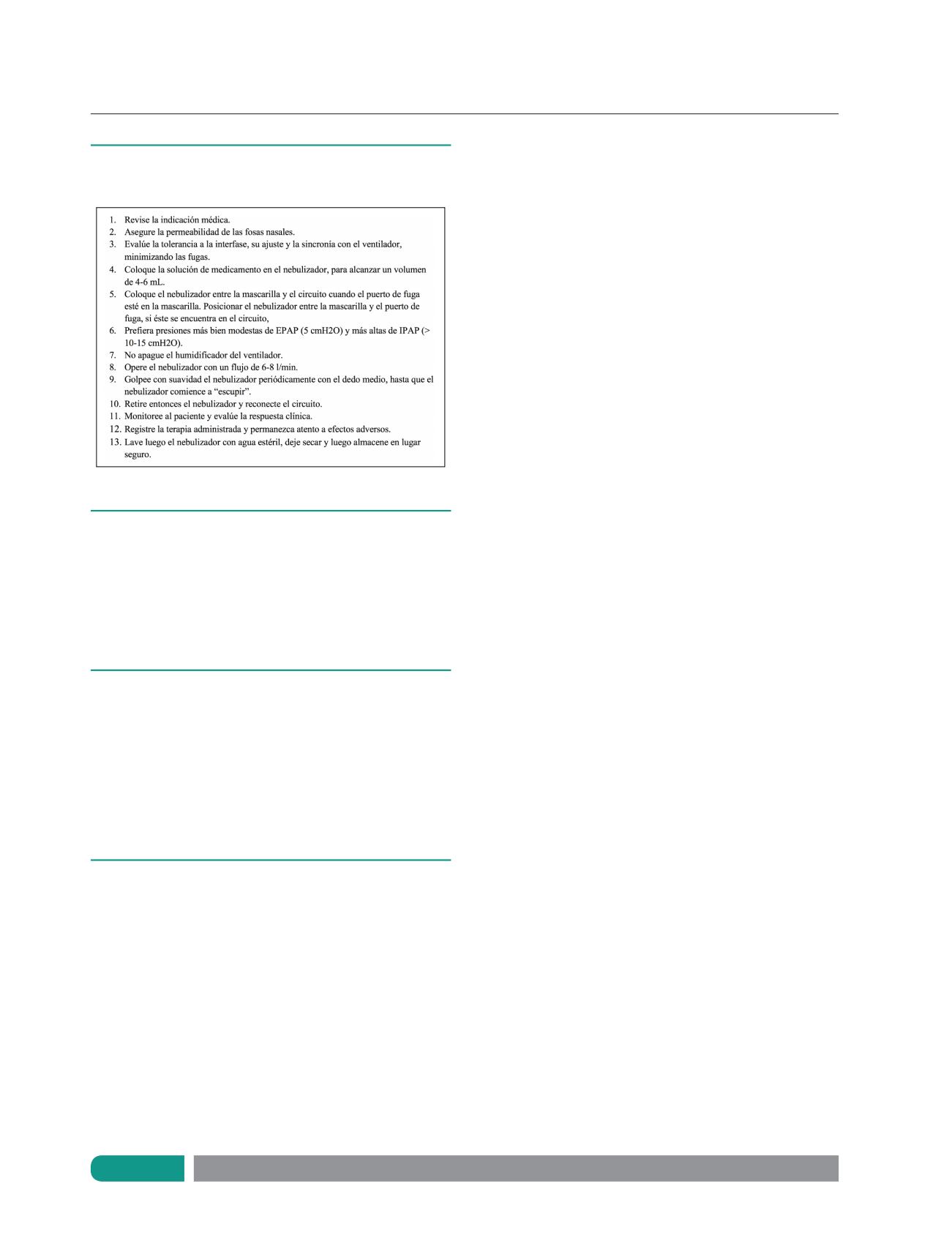

Neumol Pediatr 2018; 13 (4): 149 - 163
C o n t e n i d o d i s p o n i b l e e n h t t p : / / www. n e umo l o g i a - p e d i a t r i c a . cl
161
Terapia inhalatoria en pacientes que reciben ventilación mecánica
El autor no declara conflictos de interés ya que no posee
vínculos actuales con empresas o productos mencionados en
este artículo. Las Tablas son originales del autor, confeccionadas
en base a las referencias mencionadas en cada una de ellas.
AGRADECIMIENTOS
Por su colaboración, a los kinesiólogos Héctor Pafian de
la Unidad de Paciente Crítico Pediátrico (UPCP) del Hospital Puerto
Montt (Figuras 1 y 8), a Paula Modinger del Hospital Fundación Josefina
Martínez de Ferrari (Figuras 6B, 6D y 7) y a Claudio Torres, de la UPCP
del Hospital Víctor Ríos Ruiz, Los Ángeles (Figuras 3C y 3D). Y muy
especialmente al Dr. Francisco Prado, quien me alentó hace 10 años a
profundizar en esta apasionante área.
REFERENCIAS
1.
Gardenhire D, Burnett D, Strickland S, Myers T. A Guide to
aerosol delivery devices for respiratory therapists. 4° ed.
2017. American Association for Respiratory Care. Disponible
en:
https://www.aarc.org/wp-content/uploads/2018/03/aersol-guides-for-rts.pdf
2.
Rubin B. Inhaled corticosteroids: devices and deposition.
Paediatr Respir Rev 2004;5 Suppl A:S103-6.
3.
Carvalho T, Peters J, Williams R. Influence of particle size
on regional lung deposition- What evidence is there? Int J
Pharm 2011;406:1-10.
4.
Iñiguez F, Aguirre V. Terapia Inhalatoria. En “Enfermedades
Respiratorias del Niño”. Editores: Bertrand P, Sánchez I.
Ediciones Universidad Católica de Chile, 2° Ed. actualizada.
2016, pág. 613-21.
5.
Haddrell A, Lewis D, Church T, Vehring R, Murnane D, Reid
J. Pulmonary aerosol delivery and the importance of growth
dynamics. Ther Deliv 2017; 8:1051-61.
6.
Humidity and aerosol therapy equipment. En: White GC, ed.
Equipment Theory for Respiratory Care. Thomson Delmar
Learning, New York, 2005; 97-102.
7.
Mitchell J, Coppolo D, Nagel M. Electrostatics and
inhaled medications: influence on delivery via pressurized
metered-dose inhalers and add-on devices. Respir Care
2007;52:283-300.
8.
Kleinstreuer C, Zhang Z, Donohue J. Targeted drug-aerosol
delivery in the human respiratory system. Annu Rev Biomed
Eng 2008;10:195-220.
9.
Everard M, Devadason S, Le Souef P. In vitro assessment of
drug delivery trough an endotracheal tube using a dry power
inhaler delivery system. Thorax 1996;51:75-7.
10. Holland A, Smith F, Penny K, McCrossan G, Veitch L,
Nicholson C. Metered dose inhalers versus nebulizers for
aerosol bronchodilator delivery for adults patients receiving
mechanical ventilation in critical care units. Cochrane
Database of Systematic Reviews 2013, Issue 6. Art
N°:CD008863.
11. Trend S, Unger-Sternberger B, Devadason S, Schultz A,
Everard M. Current options in aerosolized drug therapy
for children receiving respiratory support. Anaesthesia
2017;72:1388-97.
12. Ari A, Fink J, Dhand R. Inhalation therapy in patients
receiving mechanical ventilation: an update. J Aerosol Med
Pulm Drug Deliv 2012;25:319-32.
13. Fink J, Ari A. Aerosol delivery to intubated patients. Expert
Opin Drug Deliv 2013;10:1077-93.
14. Hochrainer D, Holz H, Kreher C, Scaffidi L, Spallek M,
Watchel H. Comparison of the aerosol velocity and spray
duration of Respimat® soft mist inhaler and pressurized
metered dose inhalers. J Aerosol Med 2005;18:273-82
15. Martin A, Finlay W. Nebulizers for drug delivery to the lungs.
Expert Opin Drug Deliv 2015;12:889-900.
16. Stein S, Thiel C. The history of therapeutic aerosols: a
chronological review. J Aerosol Med Pulm Drug Deliv.
2017;30:20-41.
17. Rau J, Ari A, Restrepo R. Performance comparison of
nebulizer designs: constant-output, breath-enhanced, and
dosimetric. Respir Care 2004;49:174-9.
18. Lavorini, F. The challenge of delivering therapeutic aerosols
to asthma patients. ISRN Allergy, 2013, 102418. http://doi.
org/10.1155/2013/102418.
19. Rajapaksa A, Ho J, Qi A, Bischof R, Nguyen T, Tate M, et al.
Effective pulmonary delivery of an aerosolized plasmid DNA
vaccine via surface acoustic wave nebulization. Respir Rev
2014:15:60.
20. Waldrep J, Dhand R. Advanced nebulizer designs employing
vibrating mesh/aperture plate technologies for aerosol
generation. Curr Drug Deliv 2008;5:114-9.
21. Engstrom Carestation. Especificaciones técnicas. Disponible
en:
http://www.pvequip.cl/wp-content/uploads/2014/10/Especificaciones-Tecnicas-Engström-Español-Junio-2014.
22. Berlinski A. Assessing new technologies in aerosol medicine:
strengths and limitations. Respir Care 2015;60:833-49.
23. Rubin B. Pediatric aerosol therapy: new devices and new
Tabla 12.
Técnica para administrar un medicamento mediante un
nebulizador tipo jet en el paciente con asistencia ventilatoria no invasiva:
circuito de 1 rama, generador de flujo BiPAP (57,70).
BiPAP:
Bilevel Positive Airway Pressure.
EPAP:
Expiratory Positive Airway Pressure;
IPAP:
Inspiratory Positive Airway Pressure
















